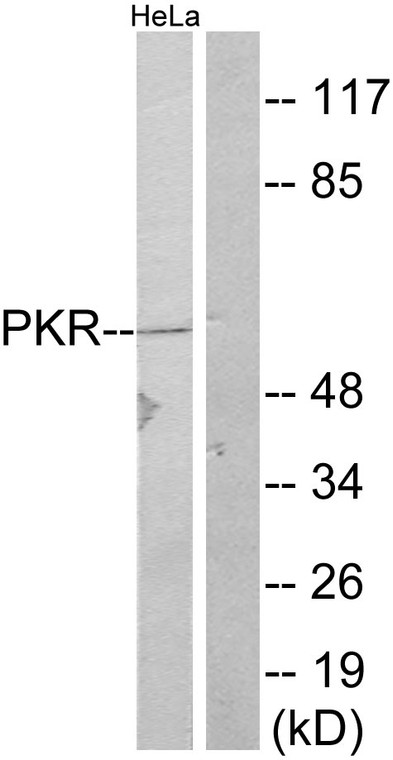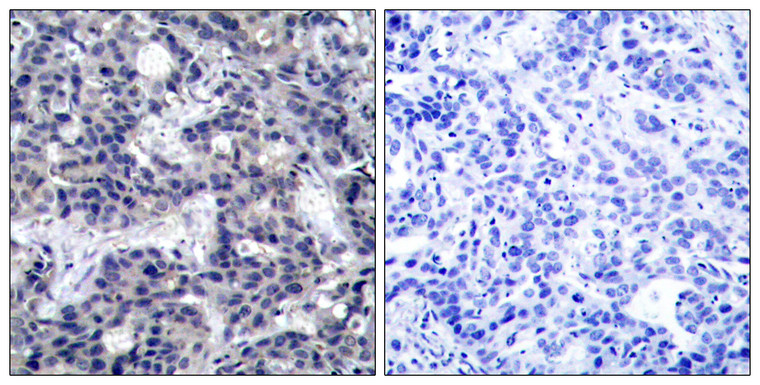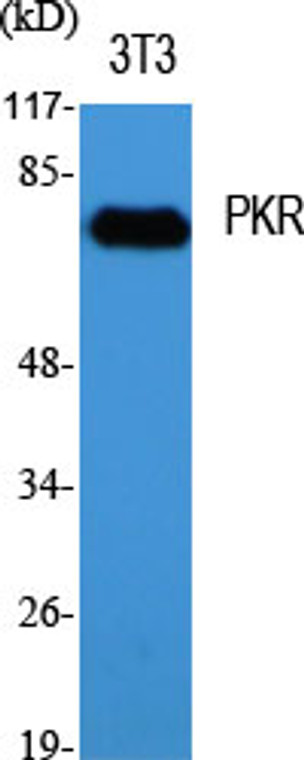| Host: |
Rabbit |
| Applications: |
WB/IHC/IF/ELISA |
| Reactivity: |
Human/Rat/Mouse |
| Note: |
STRICTLY FOR FURTHER SCIENTIFIC RESEARCH USE ONLY (RUO). MUST NOT TO BE USED IN DIAGNOSTIC OR THERAPEUTIC APPLICATIONS. |
| Short Description: |
Rabbit polyclonal antibody anti-Interferon-induced, double-stranded RNA-activated protein kinase (413-462 aa) is suitable for use in Western Blot, Immunohistochemistry, Immunofluorescence and ELISA research applications. |
| Clonality: |
Polyclonal |
| Conjugation: |
Unconjugated |
| Isotype: |
IgG |
| Formulation: |
Liquid in PBS containing 50% Glycerol, 0.5% BSA and 0.02% Sodium Azide. |
| Purification: |
The antibody was affinity-purified from rabbit antiserum by affinity-chromatography using epitope-specific immunogen. |
| Concentration: |
1 mg/mL |
| Dilution Range: |
WB 1:500-1:2000IHC 1:100-1:300ELISA 1:20000IF 1:50-200 |
| Storage Instruction: |
Store at-20°C for up to 1 year from the date of receipt, and avoid repeat freeze-thaw cycles. |
| Gene Symbol: |
EIF2AK2 |
| Gene ID: |
5610 |
| Uniprot ID: |
E2AK2_HUMAN |
| Immunogen Region: |
413-462 aa |
| Specificity: |
PKR Polyclonal Antibody detects endogenous levels of PKR protein. |
| Immunogen: |
The antiserum was produced against synthesized peptide derived from the human PKR at the amino acid range 413-462 |
| Post Translational Modifications | Autophosphorylated on several Ser, Thr and Tyr residues. Autophosphorylation of Thr-451 is dependent on Thr-446 and is stimulated by dsRNA binding and dimerization. Autophosphorylation apparently leads to the activation of the kinase. Tyrosine autophosphorylation is essential for efficient dsRNA-binding, dimerization, and kinase activation. |
| Function | IFN-induced dsRNA-dependent serine/threonine-protein kinase that phosphorylates the alpha subunit of eukaryotic translation initiation factor 2 (EIF2S1/eIF-2-alpha) and plays a key role in the innate immune response to viral infection. Inhibits viral replication via the integrated stress response (ISR): EIF2S1/eIF-2-alpha phosphorylation in response to viral infection converts EIF2S1/eIF-2-alpha in a global protein synthesis inhibitor, resulting to a shutdown of cellular and viral protein synthesis, while concomitantly initiating the preferential translation of ISR-specific mRNAs, such as the transcriptional activator ATF4. Exerts its antiviral activity on a wide range of DNA and RNA viruses including hepatitis C virus (HCV), hepatitis B virus (HBV), measles virus (MV) and herpes simplex virus 1 (HHV-1). Also involved in the regulation of signal transduction, apoptosis, cell proliferation and differentiation: phosphorylates other substrates including p53/TP53, PPP2R5A, DHX9, ILF3, IRS1 and the HHV-1 viral protein US11. In addition to serine/threonine-protein kinase activity, also has tyrosine-protein kinase activity and phosphorylates CDK1 at 'Tyr-4' upon DNA damage, facilitating its ubiquitination and proteasomal degradation. Either as an adapter protein and/or via its kinase activity, can regulate various signaling pathways (p38 MAP kinase, NF-kappa-B and insulin signaling pathways) and transcription factors (JUN, STAT1, STAT3, IRF1, ATF3) involved in the expression of genes encoding pro-inflammatory cytokines and IFNs. Activates the NF-kappa-B pathway via interaction with IKBKB and TRAF family of proteins and activates the p38 MAP kinase pathway via interaction with MAP2K6. Can act as both a positive and negative regulator of the insulin signaling pathway (ISP). Negatively regulates ISP by inducing the inhibitory phosphorylation of insulin receptor substrate 1 (IRS1) at 'Ser-312' and positively regulates ISP via phosphorylation of PPP2R5A which activates FOXO1, which in turn up-regulates the expression of insulin receptor substrate 2 (IRS2). Can regulate NLRP3 inflammasome assembly and the activation of NLRP3, NLRP1, AIM2 and NLRC4 inflammasomes. Plays a role in the regulation of the cytoskeleton by binding to gelsolin (GSN), sequestering the protein in an inactive conformation away from actin. |
| Protein Name | Interferon-Induced - Double-Stranded Rna-Activated Protein KinaseEukaryotic Translation Initiation Factor 2-Alpha Kinase 2Eif-2a Protein Kinase 2Interferon-Inducible Rna-Dependent Protein KinaseP1/Eif-2a Protein KinaseProtein Kinase Rna-ActivatedPkrProtein Kinase RTyrosine-Protein Kinase Eif2ak2P68 Kinase |
| Database Links | Reactome: R-HSA-1169408Reactome: R-HSA-169131Reactome: R-HSA-909733 |
| Cellular Localisation | CytoplasmNucleusPerinuclear RegionNuclear Localization Is Elevated In Acute LeukemiaMyelodysplastic Syndrome (Mds)MelanomaBreastColonProstate And Lung Cancer Patient Samples Or Cell Lines As Well As Neurocytes From Advanced Creutzfeldt-Jakob Disease Patients |
| Alternative Antibody Names | Anti-Interferon-Induced - Double-Stranded Rna-Activated Protein Kinase antibodyAnti-Eukaryotic Translation Initiation Factor 2-Alpha Kinase 2 antibodyAnti-Eif-2a Protein Kinase 2 antibodyAnti-Interferon-Inducible Rna-Dependent Protein Kinase antibodyAnti-P1/Eif-2a Protein Kinase antibodyAnti-Protein Kinase Rna-Activated antibodyAnti-Pkr antibodyAnti-Protein Kinase R antibodyAnti-Tyrosine-Protein Kinase Eif2ak2 antibodyAnti-P68 Kinase antibodyAnti-EIF2AK2 antibodyAnti-PKR antibodyAnti-PRKR antibody |
Information sourced from Uniprot.org
12 months for antibodies. 6 months for ELISA Kits. Please see website T&Cs for further guidance










